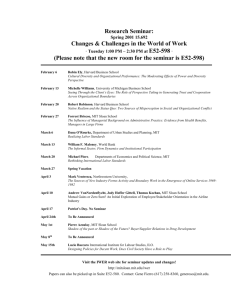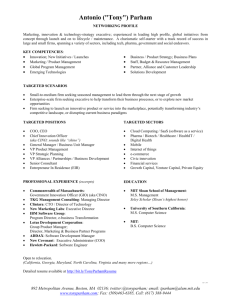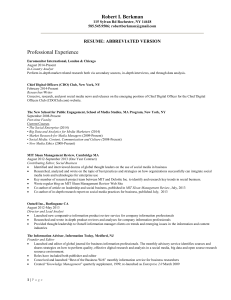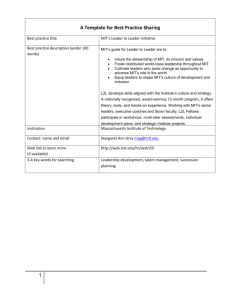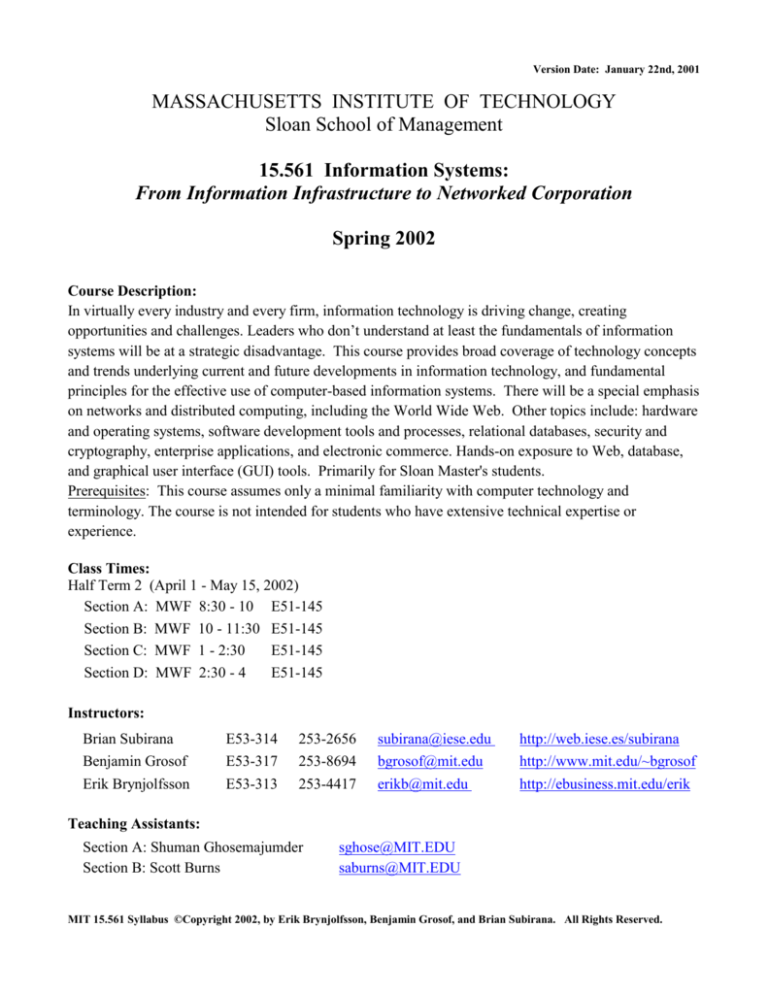
Version Date: January 22nd, 2001
MASSACHUSETTS INSTITUTE OF TECHNOLOGY
Sloan School of Management
15.561 Information Systems:
From Information Infrastructure to Networked Corporation
Spring 2002
Course Description:
In virtually every industry and every firm, information technology is driving change, creating
opportunities and challenges. Leaders who don’t understand at least the fundamentals of information
systems will be at a strategic disadvantage. This course provides broad coverage of technology concepts
and trends underlying current and future developments in information technology, and fundamental
principles for the effective use of computer-based information systems. There will be a special emphasis
on networks and distributed computing, including the World Wide Web. Other topics include: hardware
and operating systems, software development tools and processes, relational databases, security and
cryptography, enterprise applications, and electronic commerce. Hands-on exposure to Web, database,
and graphical user interface (GUI) tools. Primarily for Sloan Master's students.
Prerequisites: This course assumes only a minimal familiarity with computer technology and
terminology. The course is not intended for students who have extensive technical expertise or
experience.
Class Times:
Half Term 2 (April 1 - May 15, 2002)
Section A: MWF 8:30 - 10 E51-145
Section B: MWF 10 - 11:30 E51-145
Section C: MWF 1 - 2:30
E51-145
Section D: MWF 2:30 - 4
E51-145
Instructors:
Brian Subirana
Benjamin Grosof
Erik Brynjolfsson
E53-314
E53-317
E53-313
253-2656
253-8694
253-4417
subirana@iese.edu
bgrosof@mit.edu
erikb@mit.edu
http://web.iese.es/subirana
http://www.mit.edu/~bgrosof
http://ebusiness.mit.edu/erik
Teaching Assistants:
Section A: Shuman Ghosemajumder
Section B: Scott Burns
sghose@MIT.EDU
saburns@MIT.EDU
MIT 15.561 Syllabus ©Copyright 2002, by Erik Brynjolfsson, Benjamin Grosof, and Brian Subirana. All Rights Reserved.
15.561:
COURSE OVERVIEW
Section C: David Fitoussi
Section D: Xiaoquan Zhang
quartz@MIT.EDU
zxq@MIT.EDU
Course Secretary:
Yubettys Baez ybaez@MIT.EDU E53-320 (617)253-2656.
In Yubettys’s office suite will be kept hard copies of the course handouts, including readings handouts as
well as syllabus, lecture slides, assignments, etc..
Office Hours:
TA Office Hours: By appointment, to begin with. Fixed hours will be announced periodically
during the course, e.g., timed in conjunction with the assignments.
Instructor Office Hours: Wednesdays after class and by appointment.
Readings:
The course material is available in the course reader from Graphic Arts (E52-045). It includes all the
required readings (articles) to be covered in class. Most of the optional readings are available via the
Web, although a few are included in the course pack. There are also some optional textbooks (that are
not included in the course reader!) and recommended Web material– see below for details. And there
will be some additional readings handed out in class.
Grading:
Class participation
Three Problem Sets
Midterm Exam
Team project
(NB: there will be NO final exam.)
20%
30%
20%
30%
We view this course as a cooperative learning experience and expect students to engage the topics
through hands-on assignments, readings, and thoughtful discussions in the classroom. Assignments
provide an opportunity to gain hands-on experience with some of the tools and technologies covered in
this course. They include (a) creating a basic web site, (b) working with a Microsoft Access database and
(c) constructing a web-based survey form that uses a database to organized information provided by
people who fill out an online survey. The team project requires each team of students to produce a web
site that documents some substantive area associated with business and information technology –
whether through developing a case study or preparing a business plan. Teams should be prepared to
discuss their projects in the final class session. All assignments and the team project are to be
received by the designated TA before class on the due date.
15.561: Spring 2002
2
15.561:
COURSE OVERVIEW
Logistics of Course Communications:
The course is included in SloanSpace (http://sloanspace.mit.edu). Postings there include the syllabus,
lecture slides, and assignments. This material will be updated periodically during the course. Updates
will also be communicated on the class mailing list, and it is your responsibility to be sure you are on
this list. To get onto the mailing list, please contact Shuman Ghosemajumder <sghose@MIT.EDU>,
the TA responsible for maintaining the class mailing list.
Recommended Web materials:
The PC Webopedia (http://www.pcwebopedia.com) is a Web site that serves as an encyclopedia of
Information Technology terms. It provides excellent explanations of Information Technology terms,
together with links to additional web pages related to them. For many of the sessions, the course Web
page contains pointers to the relevant category of the PC Webopedia. We strongly encourage you to use
this valuable resource to clarify unanswered questions and to go beyond the material covered in class,
according to your own personal interests.
Optional Textbooks:
There are three optional textbooks. They are on reserve at Dewey Library.
Ron White, et. al. HOW COMPUTERS WORK (Millennium Edition), Zipf Davis (1999) .
Good introductory text on the internals of computer hardware and system software. Recommended if
you don’t have a background in science or engineering.
Price Waterhouse’s TECHNOLOGY FORECAST: 2001 (for availability, see below).
In addition to a concise technical introduction to the various topics covered, it provides excellent surveys
of the marketplace, including pointers to leading vendors and products, as well as assessments of trends
and directions. Our recommendation: If you have no previous exposure in IT , you may find this a bit
heavy. On the other hand, if you are interested in connecting the technological principles we will learn in
the lectures with the marketplace, you will probably find this an excellent reference. Ordering
Information: Available through the MIT Coop (at a huge discount compared to ordering directly from
PriceWaterhouseCoopers). If you let your section TA know by Wed. April 11 that you would like a copy,
you will save at least $20 further by being part of a single group order we will do for the class. (We will
only be doing one such group order.)
John L. Viescas. RUNNING MICROSOFT ACCESS 2000, Microsoft Press (1999).
One of the best and most detailed "bibles" on Microsoft Access.
Coverage is way beyond what will be covered in this course. This is an excellent reference book for
students who are interested in becoming Microsoft Access experts.
15.561: Spring 2002
3
15.561:
#
1
DATE
M 4/1
COURSE OVERVIEW
TOPIC
Introduction: Fundamentals of Computing (Subirana)
ASSIGNMENTS
Hand out: Team
Project Assignment
No readings.
THE TECHNOLOGY
2
W 4/3
Fundamentals of Computing II (Subirana)
No required readings.
Hand out: Problem
Set 1 – build a simple
Web home page
Optional:
Laudon, K.C. and Laudon J.P. “What is a Computer System?” in
Management Information Systems: Organization and Technology, NJ:
Prentice-Hall, 1998, pp. 192-225.
3
F 4/5
Networks (Subirana)
Mendelson, Haim, “A Note on Internet Technology.” Stanford
University Graduate School of Business, Teaching Note S-OIT-15,
July 1999, pp. 1-27.
Optional:
Peter G. W. Keen and J. Michael Cummins, Networks in Actions:
Business Choices and Telecommunications Decisions, 1994, ch. 2
(“Telecommunications Network Fundamentals”), pp. 45-88.
4
M 4/8
Databases/SQL (Subirana)
Elmasri and Navathe. Fundamentals of Database Systems,
Benjamin/Cummings, 1989: Chapter 7 (plus pp. 143-144).
5
W 4/10
“Under the Hood” of a Commercial Website (Subirana)
The New Infomediaries. McKinsey Quarterly. 1997
6
F 4/12
Wireless technologies (Subirana)
IESE SI-24-E NTT DoCoMo Mobile Multimedia (A)
--
M 4/15
Patriot’s Day – NO CLASS
MIT Sloan Holiday
15.561: Spring 2002
4
15.561:
7
W 4/17
COURSE OVERVIEW
Web Technologies Basics (Grosof)
Orfali, R. et al. Client/Server Survival Guide (3rd Edition), Wiley
1999, chapters 26-27.
Optional:
Due: Description and
members for team
project
Wright, R. The Man Who Invented the Web. Time, May 19, 1997.
8
F 4/19
Microsoft Frontpage (user interface tool for database forms and
reports) and Software Development I (Grosof)
On-line tutorial: http://www.actden.com/fp2000/java
9
M 4/22
Due: Problem Set 1
Hand out: Problem
Set 2 – Microsoft
Access
Software Development II (Grosof)
Gibbs, W.W. “Software’s Chronic Crisis,” Scientific American,
September 1994, pp. 86-95.
Brooks, Frederick P. The Mythical Man-Month, title essay of his
book, 1975.
10
W 4/24
Broadband Technologies and the Information Value-Chain
(Subirana)
HBS 9-700-069 Excite@home: Betting on a Broadband Revolution
http://apnews.excite.com/article/20020223/D7HRUARG0.html
11
F 4/26
Mid-term Exam (in class)
APPLICATIONS OF TECHNOLOGY
12
M 4/29
Enterprise Systems (Subirana)
Davenport, T.H. “Putting the Enterprise into the Enterprise System,”
Harvard Business Review, August 1998, pp. 121-131.
Optional:
Due: Problem Set 2
Hand out: Problem
Set 3 – Microsoft
Frontpage
http://www.cio.com/research/erp/index.html
13
W 5/1
B2B Information Systems / XML (Grosof)
Readings to be distributed in class.
15.561: Spring 2002
5
15.561:
14
F 5/3
COURSE OVERVIEW
Computer Security/Cryptography (Brynjolfsson)
Behar, R. Who’s reading your e-mail. Fortune, Feb. 3, 1997, pp. 5770.
VanDam, Chuck, “Encryption and Authentication”, Note
Optional:
PC Webopedia - Encryption category page
(http://www.pcwebopedia.com/Encryption_cat.html)
Terms to look up: symmetric-key cryptography, DES, public-key
encryption, RSA, Pretty Good Privacy, authentication, digital
signature, digital certificate, PKI, SSL, digital cash, smart card.
15
M 5/6
Due: Problem Set 3
Knowledge Management (Brynjolfsson)
Hansen, Nohria, Tierney “What’s Your Strategy for Managing
Knowledge” Harvard Business Review, March-April (1999) HBR
Reprint #99206
16
W 5/8
Technology, Organization and Culture
(Brynjolfsson)
Case: Woerner, S. “Networked at Cisco,” Center for eBusiness
Optional:
Brynjolfsson, E. and Hitt, L. Beyond Computation: Information
Technology, Organizational Transformation and Business
Performance, Journal of Economic Perspectives, Fall, 2000.
http://ebusiness.mit.edu/Erik/JEP%20Beyond%20Computation
%209-20.pdf
17
F 5/10
Change Management (Brynjolfsson)
Reading to be distributed in class.
Due: Team Project
Writeups
Optional:
“eBusiness Transformation” Center for eBusiness Workshop Report,
June, 2001.
Matrix of Change Website: http://ebusiness.mit.edu/moc
18
M 5/13
Team Project Summaries I (Subirana)
19
W 5/15
Team Project Summaries II; Course Wrap-up (Subirana)
Due: Team Project
Presentations
Wrap-up includes: discussion of lessons from team projects and key
course themes.
15.561: Spring 2002
6
15.561:
15.561: Spring 2002
COURSE OVERVIEW
7
15.561:
COURSE OVERVIEW
Annex: Sloan MBA Program Values and Professional Standards
The MBA Program Values Statement
Maintenance of a productive living and learning environment requires that all members of the Sloan
MBA community exercise due respect for the basic rights of one another. The Values Statement which
follows accordingly reflects this important principle.
The MBA Program Values Statement
To foster an appropriate living and learning culture, Sloan MBA students, faculty and staff:
•
Value differences and respect each other’s abilities
•
Promote effective teamwork
•
Expect academic honesty
•
Support each other’s successes
•
Help each other attain personal and professional objectives
•
Hold each other accountable for decisions made and actions taken
Sloan Professional Standards
Sloan’s Professional Standards provide a guideline for professional behavior by students, faculty, and
staff inside and outside of the classroom, and directly reflect the Values Statement above.
Sloan Professional Standards
Fundamental to the principle of independent learning and professional growth is the requirement of honesty and integrity in
the conduct of one’s academic and non-academic life.
The MIT Sloan School is committed to creating an environment in which every individual can work and study in a culture of
mutual respect. When making individual decisions we must keep in mind the interests of the many other stakeholders.
Consistent with the general goal of mutual respect, faculty, students, and staff are reminded to demonstrate:
On-time arrival to classes and presentations, with uninterrupted attendance for the duration.
On-time initiation and termination of classes and presentations.
Maintenance of a professional atmosphere. This includes, but is not limited to:
— Using respectful comments and humor;
— Employing appropriate manners and decorum, especially when food and drinks are served;
— Utilizing computers and technology suitably (e.g., silencing wireless devices, no web-browsing or emailing); and
— Refraining from distracting or disrespectful activities (e.g., avoiding side conversations and games).
Fulfillment of engagements with recruiters and speakers, or timely notification of cancellation.
Courtesy towards all guests, hosts and participants at any activity associated with the Sloan community.
Observance of the most conservative standards when one is unsure about which norms apply.
These points offer specific illustrative examples to encourage broader reflection of each individual’s impact on the Sloan
community.
Upholding these expectations and the standards upon which they are based is a shared right and responsibility for all
faculty, students and staff at the Sloan School. As a learning and professional community, we seek and deserve no less.
15.561: Spring 2002
8

